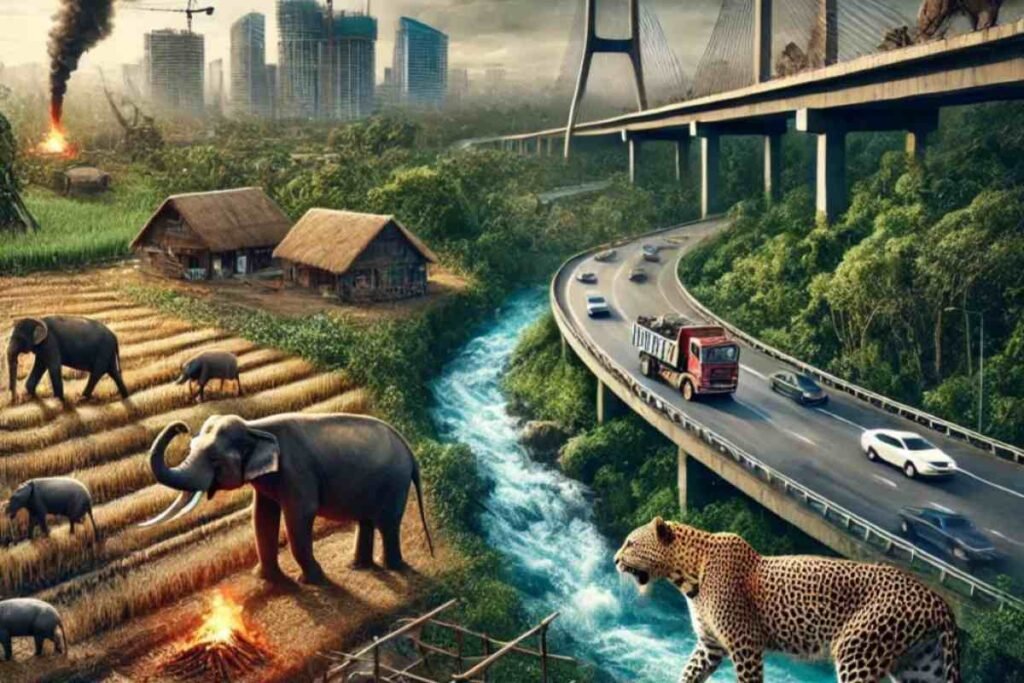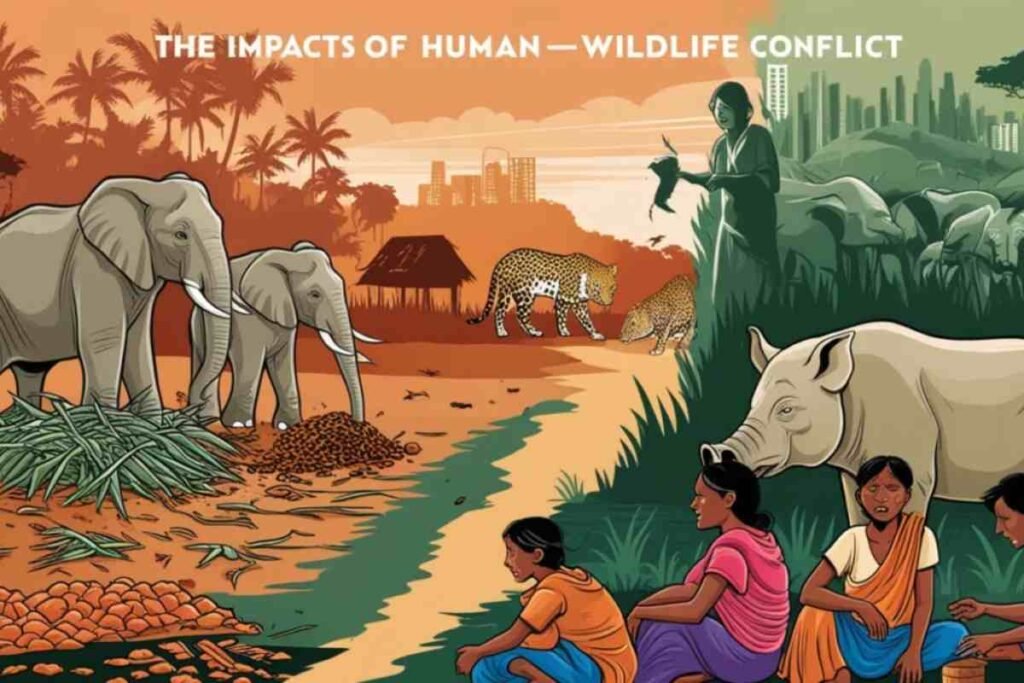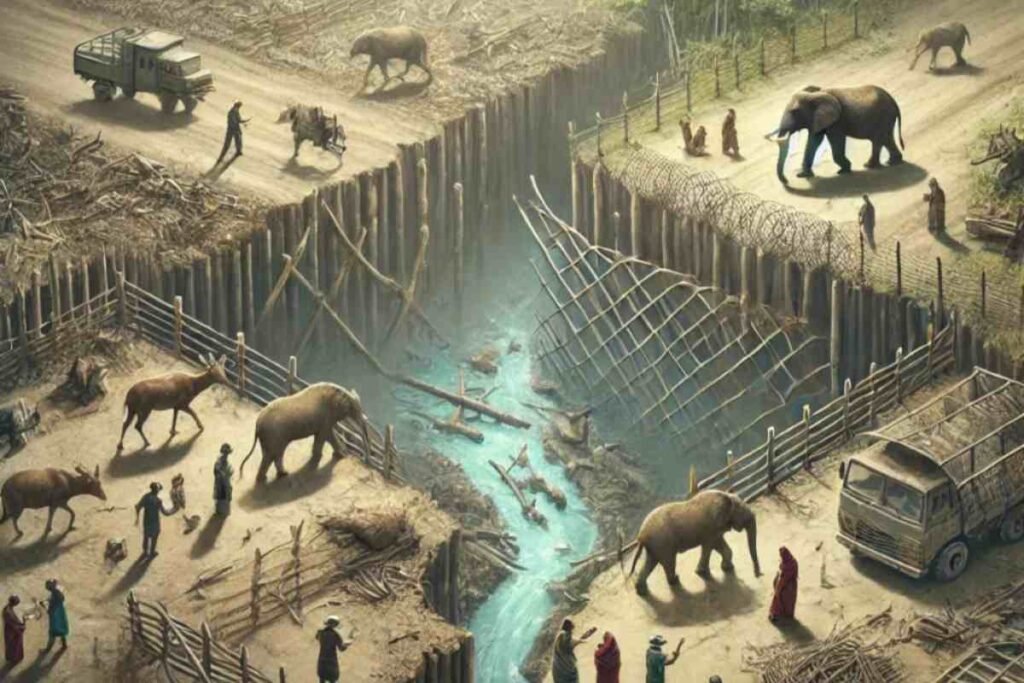Human-wildlife conflict is a pressing global concern, arising from interactions where wildlife threatens human interests, including safety, property, and livelihoods.
These conflicts often result in harm to humans and retaliatory actions against animals, leading to ecological imbalances and pushing species toward extinction.
With rising human populations, shrinking habitats, and climate change, the frequency of these conflicts is escalating.
This article delves into the root causes, global impacts, and actionable strategies for managing human-wildlife and if you are interested you can continue further.
What is Human Wildlife Conflict?

Human wildlife conflict occurs when the behavior of wildlife poses threats to human interests, resulting in property damage, loss of livelihoods, or harm to individuals. Retaliatory actions against wildlife often exacerbate the problem, creating a vicious cycle that threatens biodiversity and ecosystem health.
Why is Human wildlife conflict on the Rise?
explores the reasons behind the increasing frequency of conflicts between humans and wildlife. This includes factors such as habitat loss, urban expansion, climate change, and human encroachment into wildlife territories, all of which lead to more encounters and clashes between humans and animals.
The following factors contribute to the increasing prevalence of Human wildlife conflict:
The increasing prevalence of human-wildlife conflict is caused by factors such as habitat loss, urban expansion, and climate change.
As human activities encroach on wildlife habitats, animals are forced to move into human settlements, leading to more frequent interactions and conflicts.
Habitat Loss and Fragmentation: Deforestation, urbanization, and agricultural expansion have encroached on wildlife habitats, forcing animals into human settlements.
Climate Change: Changing weather patterns and resource scarcity drive animals to seek food and shelter in human-dominated areas.
Growing Human Populations: Population growth increases competition for land and resources, bringing humans and wildlife into closer contact.
Unsustainable Agricultural Practices: Large-scale farming near wildlife corridors intensifies encounters between humans and animals.
Impacts of Human wildlife conflict

Human wildlife conflict refers to the negative interactions between humans and wild animals, often resulting in harm to either party.
It can lead to property damage, loss of crops, livestock deaths, and even threats to human lives, while also endangering wildlife populations and habitats.
On Humans
- Economic Losses: Crop destruction, livestock predation, and property damage.
- Safety Concerns: Increased risk of injuries or fatalities.
- Food Security: Reduced agricultural productivity impacts local food supplies.
On Wildlife
- Retaliatory Killings: Animals, often endangered species, are killed to prevent further losses.
- Habitat Encroachment: Shrinking spaces force wildlife to adapt to unnatural environments.
On Conservation Efforts
- Conflicts reduce public support for wildlife conservation, making it harder to implement protective measures.
Effective Strategies to Address Human wildlife conflict
Human wildlife conflict refers to a set of 10 practical and proven methods aimed at minimizing or preventing the negative interactions between humans and wildlife.
These strategies focus on reducing damage, protecting both human communities and animal populations, and promoting peaceful coexistence through various preventive and management approaches.
Community-Based Conservation: Engaging local communities in conservation efforts creates a sense of ownership and reduces hostility toward wildlife.
Zoning and Land-Use Planning: Designating areas for agriculture, settlements, and wildlife ensures minimal overlap and reduces conflicts.
Wildlife Corridors: Protected migration routes allow animals to move freely between habitats without entering human settlements.
Non-Lethal Deterrents: Using tools like electric fences, beehive barriers, or noise-making devices helps protect crops and livestock.
Compensation Programs: Governments and NGOs can offer financial compensation for losses caused by wildlife to discourage retaliatory actions.
Education and Awareness Campaigns
Teaching communities about the importance of wildlife fosters coexistence and reduces fear-based conflicts.
Technology Integration: Innovations like GPS tracking, early-warning systems, and drones enhance monitoring and proactive conflict prevention.
Habitat Restoration: Rehabilitating degraded areas provides wildlife with alternative resources, reducing their reliance on human territories.
Legal and Policy Frameworks: Implementing laws that protect both humans and wildlife ensures long-term conflict mitigation.
Collaboration Across Sectors: Involving stakeholders like conservationists, local governments, and businesses fosters holistic solutions.
Case Studies: Learning from Success Stories
Learning from Success Stories refers to examining real-life examples where solutions to challenges, like human-wildlife conflict, have worked well.
By studying these success stories, we can learn valuable lessons and apply them to similar situations to achieve positive outcomes.
Kenya: Lion Guardians Program
- The Lion Guardians initiative employs Maasai warriors to monitor and protect lions, significantly reducing retaliatory killings.
India: Beehive Fences
- In India, farmers have successfully used beehive fences to deter elephants while promoting honey production.
Romania: Livestock Guarding Dogs
- Romania’s use of specially trained dogs has reduced livestock predation by predators like wolves and bears.
Challenges in Implementing Solutions

Challenges in implementing solutions refer to the difficulties faced when trying to put effective strategies into action.
These challenges can include lack of resources, resistance from local communities, complex environmental factors, and difficulty in monitoring and maintaining long-term efforts.
Stakeholder Conflicts: Different groups, from conservationists to farmers, often have competing priorities, making consensus difficult.
Resource Limitations: Insufficient funding and infrastructure hinder the scaling of effective interventions.
Cultural and Social Barriers: Local traditions and beliefs can shape attitudes toward wildlife, complicating implementation of solutions.
Conclusion
Human wildlife conflict is a complex yet solvable issue. By addressing the root causes, empowering communities, and adopting innovative solutions, we can transform conflict into coexistence.
Protecting wildlife is not just an environmental concern it is essential for sustainable development and global ecological balance. Together, we can create a world where humans and wildlife thrive side by side.
FAQs
Can tourism increase human wildlife conflict?
Yes, unregulated tourism can disturb animal behavior and increase human-animal interactions, raising the risk of conflict.
What role do local communities play in reducing conflict?
Local communities are key in implementing and maintaining conflict mitigation strategies through awareness, cooperation, and conservation.
Are there laws that protect people from dangerous wildlife?
Many countries have policies balancing human safety and wildlife protection, but enforcement and awareness remain challenges.
How does feeding wildlife contribute to conflict?
Feeding animals encourages dependency and bold behavior, often leading them into human spaces and escalating conflicts.
Can urban planning help prevent these conflicts?
Yes, proper zoning and development plans that consider wildlife corridors and buffer zones can greatly reduce encounters and risks.